Galton and Regression toward the Mean
| Home | | Advanced Mathematics |Chapter: Biostatistics for the Health Sciences: Correlation, Linear Regression, and Logistic Regression
Believing that human characteristics could be inherited, he was a supporter of the eugenics movement, which sought to improve human beings through selective mating.
GALTON AND REGRESSION TOWARD THE MEAN
Francis Galton (1822–1911), an anthropologist and
adherent of the scientific beliefs of his cousin Charles Darwin, studied the
heritability of such human characteristics as physical traits (height and
weight) and mental attributes (personality dimensions and mental capabilities).
Believing that human characteristics could be inherited, he was a supporter of
the eugenics movement, which sought to improve human beings through selective
mating.
Given his interest in how human traits are passed
from one generation to the next, he embarked in 1884 on a testing program at
the South Kensington Museum in London, England. At his laboratory in the
museum, he collected data from fa-thers and sons on a range of physical and
sensory characteristics. He observed among his study group that characteristics
such as height and weight tended to be inherited. However, when he examined the
children of extremely tall parents and those of extremely short parents, he
found that although the children were tall or short, they were closer to the
population average than were their parents. Fathers who were taller than the
average father tended to have sons who were taller than av-erage. However, the
average height of these taller than average sons tended to be lower than the
average height of their fathers. Also, shorter than average fathers tended to
have shorter than average sons; but these sons tended to be taller on aver-age
than their fathers.
Galton also conducted experiments to investigate
the size of sweet pea plants produced by small and large pea seeds and observed
the same phenomenon for a successive generation to be closer to the average
than was the previous generation. This finding replicated the conclusion that
he had reached in his studies of humans.
Galton coined the term “regression,” which refers
to returning toward the aver-age. The term “linear regression” got its name
because of Galton’s discovery of this phenomenon of regression toward the mean.
For more specific information on this topic, see Draper and Smith (1998), page
45.
Returning to the relationship that Galton
discovered between the height at adult-hood of a father and his son, we will
examine more closely the phenomenon of re-gression toward the mean. Galton was
one of the first investigators to create a scat-ter plot in which on one axis
he plotted heights of fathers and on the other, heights of sons. Each single
data point consisted of height measurements of one father–son pair. There was
clearly a high positive correlation between the heights of fathers and the
heights of their sons. He soon realized that this association was a
mathemat-ical consequence of correlation between the variables rather than a consequence
of heredity.
The paper in which Galton discussed his findings
was entitled “Regression to-ward mediocrity in hereditary stature.” His general
observations were as follows: Galton estimated a child’s height as

where Yˆ is the predicted or estimated child’s
height, Yˆ is the average height of
the children, X is the parent’s height for that child, and ![]() is the
average height of all parents. Apparently, the choice of X was a weighted average of the mother’s and father’s heights.
is the
average height of all parents. Apparently, the choice of X was a weighted average of the mother’s and father’s heights.
From the equation you can see that if the parent
has a height above the mean for parents, the child also is expected to have a
greater than average height among the children, but the increase Yˆ = ![]() is only 2/3 of the
predicted increase of the parent over the average for the parents. However, the
interpretation that the children’s heights tend to move toward mediocrity
(i.e., the average) over time is a fallacy sometimes referred to as the
regression fallacy.
is only 2/3 of the
predicted increase of the parent over the average for the parents. However, the
interpretation that the children’s heights tend to move toward mediocrity
(i.e., the average) over time is a fallacy sometimes referred to as the
regression fallacy.
In terms of the bivariate normal distribution, if Y represents the son’s height and X the parent’s height, and the joint
distribution has mean μx for X,
mean μy for Y, standard deviation σx for X, standard deviation σy for Y,
and correlation ρxy between X and Y, then E(Y – μy|X = x) = ρxy σy (x – μx)/σx.
If we assume σx = σy, the
equation simplifies to ρxy(x – μx). The simplified equa-tion shows mathematically
how the phenomenon of regression occurs, since 0 < ρxy < 1. All of the deviations of X about the mean must be reduced by the
multiplier ρxy, which
is usually less than 1. But the interpretation of a progression toward
mediocrity is incorrect. We see that our interpretation is correct if we switch
the roles of X and Y and ask what is the expected value of
the parent’s height (X) given the
son’s height (Y), we find mathematically that E(X
– μx|Y = y) = ρxy σx(y – μy)/σy, where μy is the overall mean for the population of the sons.
In the case when σx = σy, the equation simplifies to ρxy(y – μy). So when y is greater than μy, the expected value of X moves closer to its overall mean (μx) than Y does to its overall
mean (μy).
Therefore, on the one hand we are saying that tall
sons tend to be shorter than their tall fathers, whereas on the other hand we
say that tall fathers tend to be short-er than their tall sons. The prediction
for heights of sons based on heights of fathers indicates a progression toward
mediocrity; the prediction of heights of fathers based on heights of sons
indicates a progression away from mediocrity. The fallacy lies in the
interpretation of a progression. The sons of tall fathers appear to be shorter
be-cause we are looking at (or conditioning on) only the tall fathers. On the
other hand, when we look at the fathers of tall sons we are looking at a
different group because we are conditioning on the tall sons. Some short
fathers will have tall sons and some tall fathers will have short sons. So we
err when we equate these conditioning sets. The mathematics is correct but our
thinking is wrong. We will revisit this fallacy again with students’ math
scores.
When trends in the actual heights of populations
are followed over several gen-erations, it appears that average height is
increasing over time. Implicit in the re-gression model is the contradictory
conclusion that the average height of the popu-lation should remain stable over
time. Despite the predictions of the regression model, we still observe the
regression toward the mean phenomenon with each gen-eration of fathers and
sons.
Here is one more illustration to reinforce the idea
that interchanging the predic-tor and outcome variables may result in different
conclusions. Michael Chernick’s son Nicholas is in the math enrichment program
at Churchville Elementary School in Churchville, Pennsylvania. The class consists
of fifth and sixth graders, who take a challenging test called the Math
Olympiad test. The test consists of five problems, with one point given for
each correct answer and no partial credit given. The possi-ble scores on any
exam are 0, 1, 2, 3, 4, and 5. In order to track students’ progress, teachers
administer the exam several times during the school year. As a project for the
American Statistical Association poster competition, Chernick decided to look
at the regression toward the mean phenomenon when comparing the scores on one
exam with the scores on the next exam.
Chernick chose to compare 33 students who took both
the second and third ex-ams. Although the data are not normally distributed and
are very discrete, the linear model provides an acceptable approximation; using
these data, we can demonstrate the regression toward the mean phenomenon. Table
12.7 shows the individual stu-dent’s scores and the average scores for the
sample for each test.
Figure 12.10 shows a scatter plot of the data along
with the fitted least squares regression line, its equation, and the square of
the correlation.
The term R2
(Pearson correlation coefficient squared) when multiplied by 100 refers to the
percentage of variance that an independent variable (X) accounts for in the dependent variable (Y). To find the Pearson correlation coefficient estimate of the
relationship between scores for exam # 2 and exam # 3, we need to find the
square root of R2, which
is shown in the figure as 0.3901; thus, the Pearson correla-tion coefficient is
0.6246. Of the total variance in the scores, almost 40% of the variance in the
exam # 3 score is explained by the exam # 2 score. The variance in exam scores
is probably attributable to individual differences among students. The
TABLE 12.7. Math Olympiad Scores
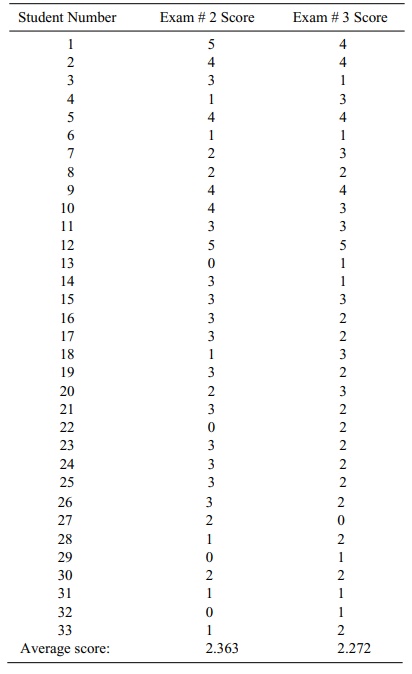
In Table 12.8, we use the regression equation shown
in Figure 12.10 to predict the individual exam # 3 scores based on the exam # 2
scores. We also can observe the regression toward the mean phenomenon by noting
that for scores of 0, 1, and 2 (all below the average of 2.272 for exam # 3),
the predicted values for Y are higher
than the actual scores, but for scores of 3, 4, and 5 (all above the mean of
2.272), the predicted values for Y
are lower than the actual scores. Hence, all predicted scores
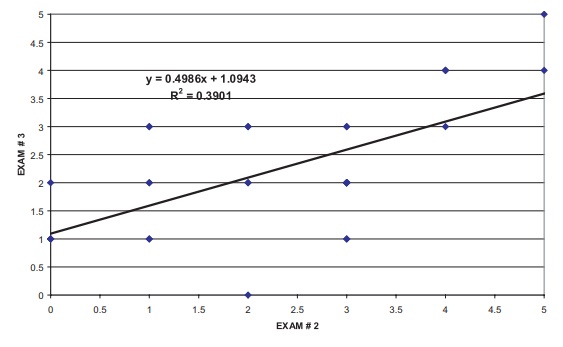
Figure 12.10. Linear regression of olympiad scores of advanced students predicting exam # 3 from exam # 2.
Note that a property of the least squares estimate
is that if we use x = 2.363, the mean
for the x’s, then we get an estimate
of y = 2.272, the mean of the y’s. So if a student had a score that
was exactly equal to the mean for exam # 2, we would pre-dict that the mean of
the exam # 3 scores would be that student’s score for exam # 3. Of course, this
hypothetical example cannot happen because the actual scores can be only
integers between 0 and 5.
Although the average scores on exam # 3 are
slightly lower than the average scores on exam # 2. the difference between them
is not statistically significant, according to a paired t test (t = 0.463, df = 32).
TABLE 12.8. Regression toward the Mean Based on Predicting Exam #3
Scores from Exam # 2 Scores
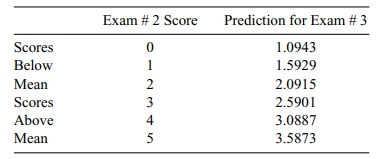
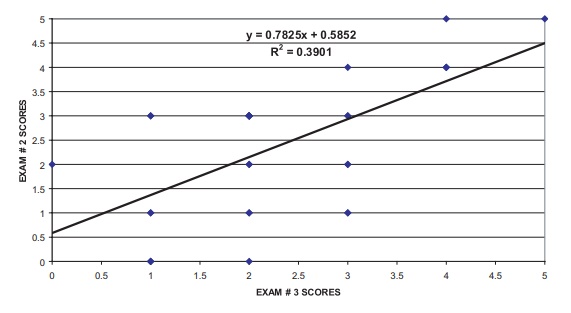
Figure 12.11. Linear regression of olympiad
scores predicting exam # 2 from exam # 3, advanced stu-dents (tests reversed).
To demonstrate that it is flawed thinking to
surmise that the exam # 3 scores tend to become more mediocre than the exam # 2
scores, we can turn the regression around and use the exam # 3 scores to
predict the exam # 2 scores. Figure 12.11 ex-hibits this reversed prediction
equation.
Of course, we see that the R2 value remains the same (and also the Pearson
cor-relation coefficient); however, we obtain a new regression line from which
we can demonstrate the regression toward the mean phenomenon displayed in Table
12.9.
Since the average score on exam # 2 is 2.363, the
scores 0, 1, and 2 are again be-low the class mean for exam # 2 and the scores
3, 4, and 5 are above the class mean for exam # 2. Among students who have exam
# 3 scores below the mean, the pre-diction is for their scores on exam # 2 to
increase toward the mean score for exam #2. The corresponding prediction among
students who have exam # 3 scores above the mean is that their scores on exam #
2 will decrease. In this case, the degree of shift between actual and predicted
scores is less than in the previous case in which
TABLE 12.9. Regression toward the Mean Based on Predicting Exam # 2
Scores from Exam # 3 Scores
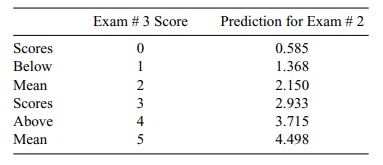
Now let’s examine the fallacy of our thinking
regarding the trend in exam scores toward mediocrity. The predicted scores for
exam # 3 are closer to the mean score for exam # 3 than are the actual scores
on exam # 2. We thought that both the lower predicted and observed scores on
exam # 3 meant a trend toward mediocrity. But the predicted scores for exam # 2
based on scores on exam # 3 are also closer to the mean of the actual scores on
exam # 2 than are the actual scores on exam # 3. This finding indicates a trend
away from mediocrity in moving in time from scores on exam # 2 to scores on
exam # 3. But this is a contradiction because we observed the opposite of what
we thought we would find. The flaw in our thinking that led to this
contradiction is the mistaken belief that the regression toward the mean
phenome-non implies a trend over time.
The fifth and sixth grade students were able to
understand that the better students tended to receive the higher grades and the
weaker students the lower grades. But chance also could play a role in a
student’s performance on a particular test. So stu-dents who received a 5 on an
exam were probably smarter than the other students and also should be expected
to do well on the next exam. However, because the maximum possible score was 5,
by chance some students who scored 5 on one exam might receive a score of 4 or
lower on the next exam, thus lowering the ex-pected score below 5.
Similarly, a student who earns a score of 0 on a
particular exam is probably one of the weaker students. As it is impossible to
earn a score of less than 0, a student who scores 0 on the first exam has a
chance of earning a score of 1 or higher on the next exam, raising the expected
score above 0. So the regression to the mean phe-nomenon is real, but it does
not mean that the class as a group is changing. In fact, the class average
could stay the same and the regression toward the mean phenome-non could still
be seen.
Related Topics
